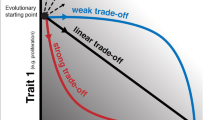Abstract
Landscapes play an important role in many areas of biology, in which biological lives are deeply entangled. Here we discuss a form of landscape in evolutionary biology which takes into account (1) initial growth rates, (2) mutation rates, (3) resource consumption by organisms, and (4) cyclic changes in the resources with time. The long-term equilibrium number of surviving organisms as a function of these four parameters forms what we call a success landscape, a landscape we would claim is qualitatively different from fitness landscapes which commonly do not include mutations or resource consumption/changes in mapping genomes to the final number of survivors. Although our analysis is purely theoretical, we believe the results have possibly strong connections to how we might treat diseases such as cancer in the future with a deeper understanding of the interplay between resource degradation, mutation, and uncontrolled cell growth.




Similar content being viewed by others
References
Austin, R.H., Beeson, K.W., Eisenstein, L., Frauenfelder, H., Gunsalus, I.C.: Dynamics of ligand-binding to myoglobin. Biochemistry 14, 5355–5373 (1975)
Austin, R.H., et al.: Activation-energy spectrum of a biomolecule - photodissociation of carbonmonoxy myoglobin at low-temperatures. Phys. Rev. Lett. 32, 403–405 (1974)
Frauenfelder, H., Wolynes, P.G., Austin, R.H.: Biological physics. Rev. Mod. Phys. 71, S419–S430 (1999)
Wright, S.: The roles of mutation, inbreeding, crossbreeding and selection in evolution. Proceedings of the Sixth International Congress on Genetics 1, 356–366 (1932)
Crewe, P., Gratwick, R., Grafen, A.: Defining fitness in an uncertain world. J. Math. Biol. 76, 1059–1099 (2018)
McCandlish, D.M.: Visualizing fitness landscapes. Evolution 65, 1544–1558 (2011)
Vincent, T.L., Brown, J.S.: Evolutionary Game Theory, Natural Selection, and Darwinian Dynamics (Cambridge University Press, 2005)
Turner, R.B., Securities, U.S., Commission., E.: Madoff Ponzi scheme : SEC failure and why. Financial institutions and services (Nova Science Publishers, New York, 2010)
DeAngelis, D.L., Zhang, B., Ni, W.M., Wang, Y.S.: Carrying capacity of a population diffusing in a heterogeneous environment. Mathematics 8, 49 (2020)
Wright, S.: The genetical theory of natural selection. J. Heredity 21(8), 349–356 (1930)
Shi, X.Q., Long, W., Li, Y.Y., Deng, D.S., Wei, Y.L.: Research on the performance of multi-population genetic algorithms with different complex network structures. Soft. Comput. 24, 13441–13459 (2020)
Oksanen, L., Oksanen, T.: The logic and realism of the hypothesis of exploitation ecosystems. Am. Nat. 155, 703–723 (2000)
Fenchel, T., Finlay, B.J.: Ecology and Evolution in Anoxic Worlds (Oxford University Press, 1995)
Jorgensen, B.B.: Deep subseafloor microbial cells on physiological standby. Proc. Natl. Acad. Sci. U.S.A. 108, 18193–18194 (2011)
McMahon, S., Parnell, J.: Weighing the deep continental biosphere. FEMS Microbiol. Ecol. 87, 113–120 (2014)
Hamming, R.W.: Error detecting and error correcting codes. Bell Syst. Tech. J. 29, 147–160 (1950)
Getz, W.M.: A unified approach to multispecies modeling. Nat. Resour. Model. 5, 393–421 (1991)
Getz, W.M.: Metaphysiological and evolutionary dynamics of populations exploiting constant and interactive resources: r-k selection revisited. Evol. Ecol. 7, 287–305 (1993)
Phan, T.V., Wang, G., Liu, L., Austin, R.H.: Bootstrapped motion of an agent on an adaptive resource landscape. Symmetry 13, 225 (2021)
Wang, G. et al.: Emergent field-driven robot swarm states. Phys. Rev. Lett. 126, 108002 (2021)
Vafa, C.: The string landscape and the swampland. (2005) https://arxiv.org/abs/hep-th/0509212
Cauchy, A.L.: Cours d’analyse de l’École royale polytechnique: premiére partie: analyse algébrique (Editrice CLUEB, 1821)
Acknowledgements
We would like to thank Hans Frauenfelder, without whom this subject would have remained strictly the province of ecologists, and probably not a success. This work was supported in part by the National Science Foundation, through the Center for the Physics of Biological Function (PHY-1734030).
Author information
Authors and Affiliations
Corresponding author
Additional information
Publisher’s Note
Springer Nature remains neutral with regard to jurisdictional claims in published maps and institutional affiliations.
This article belongs to the Topical Collection: The Revolutionary Impact of Landscapes in Biology
Guest Editors: Robert Austin, Shyamsunder Erramilli, Sonya Bahar
Rights and permissions
About this article
Cite this article
Phan, T.V., Wang, G., Do, T.K. et al. It doesn’t always pay to be fit: success landscapes. J Biol Phys 47, 387–400 (2021). https://doi.org/10.1007/s10867-021-09589-2
Received:
Accepted:
Published:
Issue Date:
DOI: https://doi.org/10.1007/s10867-021-09589-2




